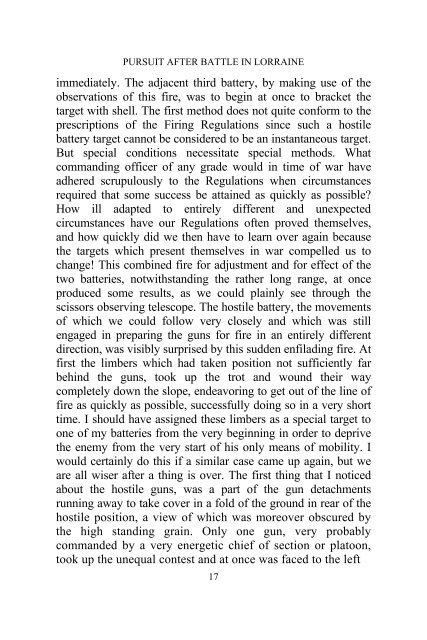the field artillery journal - Fort Sill - U.S. Army
the field artillery journal - Fort Sill - U.S. Army
the field artillery journal - Fort Sill - U.S. Army
Create successful ePaper yourself
Turn your PDF publications into a flip-book with our unique Google optimized e-Paper software.
PURSUIT AFTER BATTLE IN LORRAINE<br />
immediately. The adjacent third battery, by making use of <strong>the</strong><br />
observations of this fire, was to begin at once to bracket <strong>the</strong><br />
target with shell. The first method does not quite conform to <strong>the</strong><br />
prescriptions of <strong>the</strong> Firing Regulations since such a hostile<br />
battery target cannot be considered to be an instantaneous target.<br />
But special conditions necessitate special methods. What<br />
commanding officer of any grade would in time of war have<br />
adhered scrupulously to <strong>the</strong> Regulations when circumstances<br />
required that some success be attained as quickly as possible?<br />
How ill adapted to entirely different and unexpected<br />
circumstances have our Regulations often proved <strong>the</strong>mselves,<br />
and how quickly did we <strong>the</strong>n have to learn over again because<br />
<strong>the</strong> targets which present <strong>the</strong>mselves in war compelled us to<br />
change! This combined fire for adjustment and for effect of <strong>the</strong><br />
two batteries, notwithstanding <strong>the</strong> ra<strong>the</strong>r long range, at once<br />
produced some results, as we could plainly see through <strong>the</strong><br />
scissors observing telescope. The hostile battery, <strong>the</strong> movements<br />
of which we could follow very closely and which was still<br />
engaged in preparing <strong>the</strong> guns for fire in an entirely different<br />
direction, was visibly surprised by this sudden enfilading fire. At<br />
first <strong>the</strong> limbers which had taken position not sufficiently far<br />
behind <strong>the</strong> guns, took up <strong>the</strong> trot and wound <strong>the</strong>ir way<br />
completely down <strong>the</strong> slope, endeavoring to get out of <strong>the</strong> line of<br />
fire as quickly as possible, successfully doing so in a very short<br />
time. I should have assigned <strong>the</strong>se limbers as a special target to<br />
one of my batteries from <strong>the</strong> very beginning in order to deprive<br />
<strong>the</strong> enemy from <strong>the</strong> very start of his only means of mobility. I<br />
would certainly do this if a similar case came up again, but we<br />
are all wiser after a thing is over. The first thing that I noticed<br />
about <strong>the</strong> hostile guns, was a part of <strong>the</strong> gun detachments<br />
running away to take cover in a fold of <strong>the</strong> ground in rear of <strong>the</strong><br />
hostile position, a view of which was moreover obscured by<br />
<strong>the</strong> high standing grain. Only one gun, very probably<br />
commanded by a very energetic chief of section or platoon,<br />
took up <strong>the</strong> unequal contest and at once was faced to <strong>the</strong> left<br />
17

















